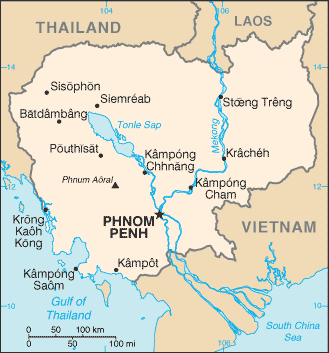Cambodia

The place where everybody goes on vacation, Cambodia is full of jungles, guerilla warfare, and women saying “Me love you long time” (Vietnamese women, mind you). Or at least, that’s what the media wants you to think, regardless of the Unfortunate Implications.
Once the Khmer Empire, disputes with its neighbors pushed King Norodom to become a protectorate of France and, eventually, part of the French Indochina. When Norodom died, the French began to manipulate the elections of the next kings to ensure the Cambodian submission. Eventually they enthroned the King Norodom Sihanouk, thinking they could manipulate him. Unfortunately for them, he was Genre Savvy enough to realize it and achieved the country’s independence in 1953.
Then The Vietnam War came. Officialy, Cambodia was neutral, even though its sympathies were with the communists. This and the fact that some Vietcong forces along with the communist guerrillas of Cambodia, the Khmer Rouge, sheltered in Cambodian soil prompted the United States to support a coup led by General Lon Nol, hastening the falling of the country into a civil war. And just to add insult to injury, the States decided to bomb Cambodia without warning to catch the communists unaware. They did, but they also caught the Cambodians and the US representatives in Cambodia off-guard.
The civil war ended in 1975 with the victory of the Khmer Rouge and their leader, Pol Pot. They renamed the country Democratic Kampuchea and decided to move the population to the countryside on forced marches, on an attempt of starting from zero the nation. The harsh conditions, forced works and famine caused thousands of deaths. The Khmer Rouge also destroyed anything considered Western, including libraries and temples, and started to persecute ethnic and religious minorities (Chinese, Vietnamese, Buddhist monks, Muslims, Catholics), anyone with a connection with the old regime or international agencies and anyone considered an intellectual (usually that meant anyone who used to work at libraries, universities or hospitals, or anyone who wore eyeglasses). Their motto was "To keep you is no benefit; to destroy you is no loss." Pol Pot's regime led to the death of around 2 million people out of a population of 8 million.
In 1978, Vietnam invaded Cambodia, got rid of the Khmer Rouge and put a puppet state in its place, the People’s Republic of Kampuchea, while the Khmer Rouge controlled much of the country and, eventually, a third faction of royalists called Khmer People’s National Liberation Front appeared on the scene. This civil war continued until 1991, when an agreement between the parts could be achieved.
Cambodia today is a constitutional monarchy (unusually for an ex-communist country, they not only restored the monarchy, but also restored the former monarch) that, aside of a coup in 1997, has a steady government.
The most famous tourist traps landmarks are Angkor Wat (the building seen on the flag), a humongous temple complex, home of Buddhist tradition (formerly Hindu) and the killing fields, where the mass killings of the Khmer Rouge took place and the hundreds of skulls are displayed for the whole world to see the atrocities of Pol Pot and his followers.
Cambodia also has a dispute with Thailand about the Preah Vihear Temple, an Hindu temple built during the reign of the Khmer Empire. The temple was awarded by the International Court of Justice to Cambodia, who has claimed it because to its historical significance and the French border lines, but Thailand still refuses to let it go. Regular skirmishes tend to happen around the temple from time to time as a result; usually they try to aim to the other army and miss the temple, though.
Cambodia in fiction:
- The Killing Fields, a British movie about a couple of journalists, a British and a Cambodian, whose friendship is suddenly torn apart by the Khmer Rouge regime.
- The documentary S-21: The Khmer Rouge Killing Machine, about the S21 extermination camp.
- Holly, about an American in Cambodia who discovers the sordid world of child prostitution, and decides to rescue a 12-year-old Vietnamese girl from that grim fate.
- Holy Lola is about a French couple who come to Cambodia in order to adopt a baby. The director of the aforementioned documentary S-21 shows up As Himself to provide a bit of perspective on recent Cambodian history.
- The song “Holiday in Cambodia”, the Trope Namer of the eponymous trope, deals in length with the usual stereotype of the zone. It also has mentions of the Khmer Rouge and Pol Pot.
The Cambodian flag
